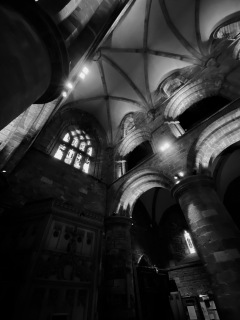
There are a handful of them along the seafront at Grange-over-Sands. They lie quietly beneath the promenade, encased in the stonework crafted by Victorian engineers, whose design allowed the water to pass beneath the all-important railway tracks.
They carry the amalgamated water of several small streams into the turbulent waters of Morecambe Bay… and backwards when the tide is high – which is quite a sight…
At the far end of the creek (see the photo) is a small beach. Really, you need wellingtons to get to the meeting point of water and bay. Families are often to be see trudging back to the shore covered in mud, having underestimated the marshy salt flat, which returns wonderful lamb, but very dirty humans..
I would have loved this little creek as a child. We used to go out ‘for a run’ on most Sundays. In my parents’ car, any sighting of a creek was met with excited pointing from the back seat. For me, there was – and is – something utterly magical about the fact that the vast wildness of the ocean can flow gently inland into such beautiful features.
I’m tempted to draw a male-female metaphor, but I’m not so sure, and suspect that something more subtle is at work in the deeper layers of our selves that draws out these symbolic parallels.
A deeper contemplation sees the sea operating on an emotional, female level, showing the masculine land how it, too, can be penetrated by the imaginative gentleness of inspiring water.

Around the curve of Morecambe Bay and south of Lancaster is the village of Condor Green. Here is a wonderful creek that is deep enough to float sizeable boats, and navigate them – carefully – into the sea near Lancaster’s old port at Glasson Dock. It’s a less expensive option than a mooring inside the sheltered waters of the dock. It’s also perilous, and a handful of boats have been wrecked by storms over the years.
I remember when, as a young boy, my parents stopped the car so that I could take a look at this delight. Years later, I returned on my first vehicle – a Ducati motorcycle – and simply sat by the creek, watching the tide fill its contours. It’s a vivid and very happy memory; and one that still makes me smile with its well remembered sense of freedom and discovery.

To close… The photo, above, was taken inside the basin at Glasson Dock – beyond the reach of the nearby creek. It shows that even sheltered waters are not safe. The boat – whose remains now lie beneath the surface – was wrecked in a storm, but towed to the side of the dock, where it gradually rotted to its present state. Ironically, the only visible remnant is the ship’s wheel, occupied in my shot, by a family of ducks.
©Stephen Tanham 2021
Stephen Tanham is a Director of the Silent Eye, a journey through the forest of personality to the dawn of Being.
http://www.thesilenteye.co.uk and http://www.suningemini.blog




























Hi Steve, I enjoyed this post and your beautiful pictures and reflections. In South Africa, a marsh is called a vlei and there are a lot of wild birds. I’ve never heard of a body of water called a creek here, I assume the name comes from the Victorian stone work. We have streams, rivulets, and lagoons.
LikeLiked by 1 person
I didn’t realise that, Robbie. Thank you. I know it’s shared with the USA. I will always find them delightful, no matter what name they have 😎
LikeLike
Something very symbolic about that half submerged wheel and life going on about it. Chris
LikeLiked by 1 person
Thank you, Chris. Quite an unusual image!
LikeLiked by 1 person